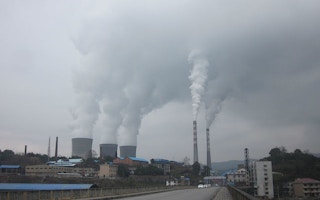Whatever mixture of motives lies behind the announcement by President Xi Jinping that his country’s carbon dioxide emissions will peak before 2030, resulting in carbon neutrality before 2060, China’s climate lead offers the prospect of a new era in world affairs.
It alters the face of international negotiations to tackle the climate crisis and boosts hopes that catastrophic global heating can still be avoided.
It is not quite a month since the president took everyone by surprise by making the announcement at the United Nations. Cynics immediately began to question his motives.
Was he trying to corner the vast market in renewables, was he trying to upstage climate-denying and coal-loving President Trump, was he trying to divert attention from internal human rights issues and Hong Kong, or from accusations against China over the Covid crisis? Was he trying re-cast himself as a world leader on environmental matters?
Few seemed generous enough to accept that President Xi was making the announcement because he was genuinely concerned about the effects of climate change on China and the rest of the planet.
Either way, the President’s new targets were certainly a remarkable turnaround. Although there have been more positive statements recently, for more than a decade at successive climate talks China, along with the rest of the developing world, regarded climate change as the developed nations’ problem.
The old industrial countries of the EU, the US and Japan had caused global heating by burning fossil fuels, they argued, so it was up to them to solve the crisis. The immediate job for the developing world’s leaders was to raise their citizens’ living standards, and to worry about their domestic carbon emissions later.
But this was never the whole story. Chinese scientists had long pointed out to its leaders that the country’s future was as bleak as any other nation’s in the world if climate change was not controlled – and quickly.
The major rivers that feed Chinese agriculture will dry up as the glaciers on the Himalayas and the Tibetan plateau disappear; typhoons will regularly threaten the populous south; and the deserts of the north will grow.
And more recently fast-accelerating sea level rise has begun to threaten the economic powerhouse of Shanghai and much of the low-lying coast with inundation.
In addition, since the Beijing Olympics in 2008 it has been clear that air pollution from coal-burning and traffic fumes is a serious economic and health issue in China, while some drastic measures have succeeded in improving air quality.
On 12 October 18 Chinese think tanks combined to put some flesh on the bare bones of President Xi’s bold announcement. In a report published by the Institute of Climate Change and Sustainable Development at Tsinghua University, Beijing, they said immediate carbon cuts were required to keep temperature increases within 1.5°C by 2050.
Globally significant
Reuters news agency reported that a seminar held in Beijing to launch the Institute ’s report was attended by China’s top officials responsible for shaping the country’s energy policy.
One of the report’s contributors, He Jiankun, vice-director of the National Expert Committee on Climate Change, told the meeting: “China should strictly control coal consumption and the expansion of coal-fired power capacity in the next five years, aiming to cap carbon emissions from coal sectors by 2025 and even realise negative growth.
“China is still expected to see the growth of natural gas consumption in 2026-2030, so the growth of carbon emissions from gas use should be offset by the reduction from the coal sector.”
The report also called for China to cut its carbon intensity – the amount of carbon dioxide emissions per GDP unit – by 65 per cent by 2030 from 2015 levels, and to raise non-fossil fuel consumption to 25 per cent by 2030.
This is way above anything that the Chinese government has committed to in the annual UN climate talks and would mean a drastic change in direction, since new coal power stations are still being constructed in large numbers to meet an ever-growing energy demand.
Whatever the motives behind these reduction targets, they matter hugely to the rest of the world. China is currently the world’s largest carbon emitter, with about 29 per cent of the total. This is mainly due to massive coal burning for electricity and for major heavy industries like steel-making, which have moved there from Europe and the US. Switching away from coal would make an immediate difference.
Eye on exports
While critics, particularly climate deniers and right-wing think tanks in the US and Europe, constantly remind the world of Chinese coal-burning habits, they often neglect to mention that the country is a world leader in on-shore wind energy and solar power.
China is also aiming to soon have the largest off-shore wind market, overtaking the United Kingdom.
This might be the key to the President’s thinking. China has a massive domestic demand for renewables, but with wind and solar being the two fastest-growing industries in the world the export market is a great prize.
With President Trump firmly stuck in the fossil fuel age, China has an opportunity to become the lead provider of the technology that many countries in the world need to meet their climate targets.
Depending on who wins the US election on 3 November, President Xi may consolidate his renewables lead at leisure, or be in a race against the Democrat contender, Joe Biden, who has pledged to turn America from a climate laggard to a world leader.
If Biden does win he may find President Xi is already a lap ahead, and hard to overtake.
This story was published with permission from Climate News Network.










